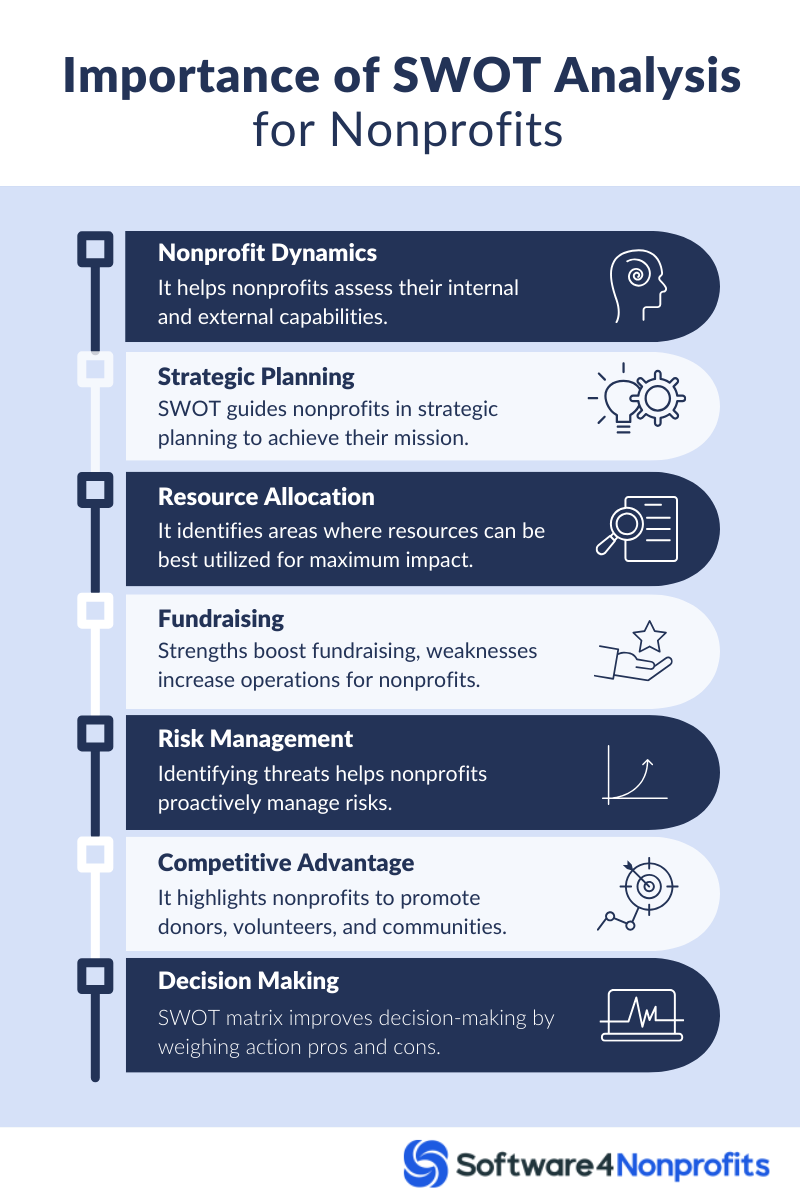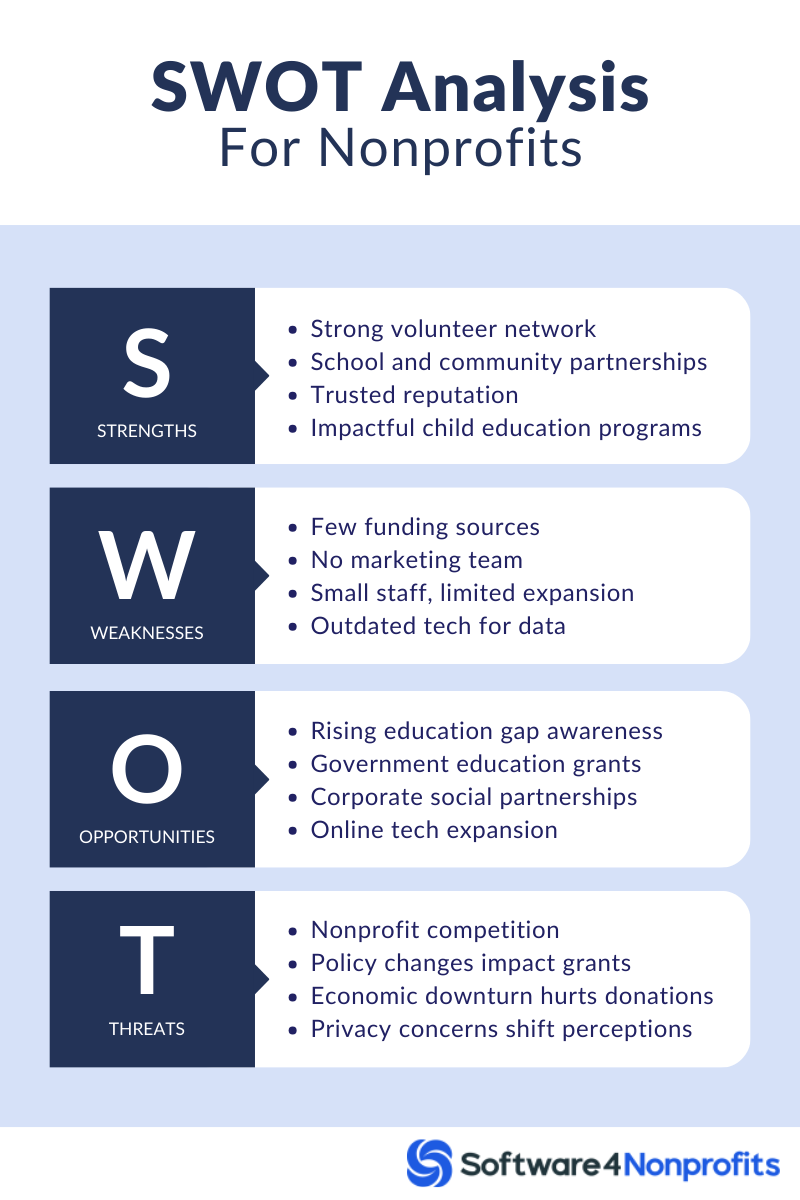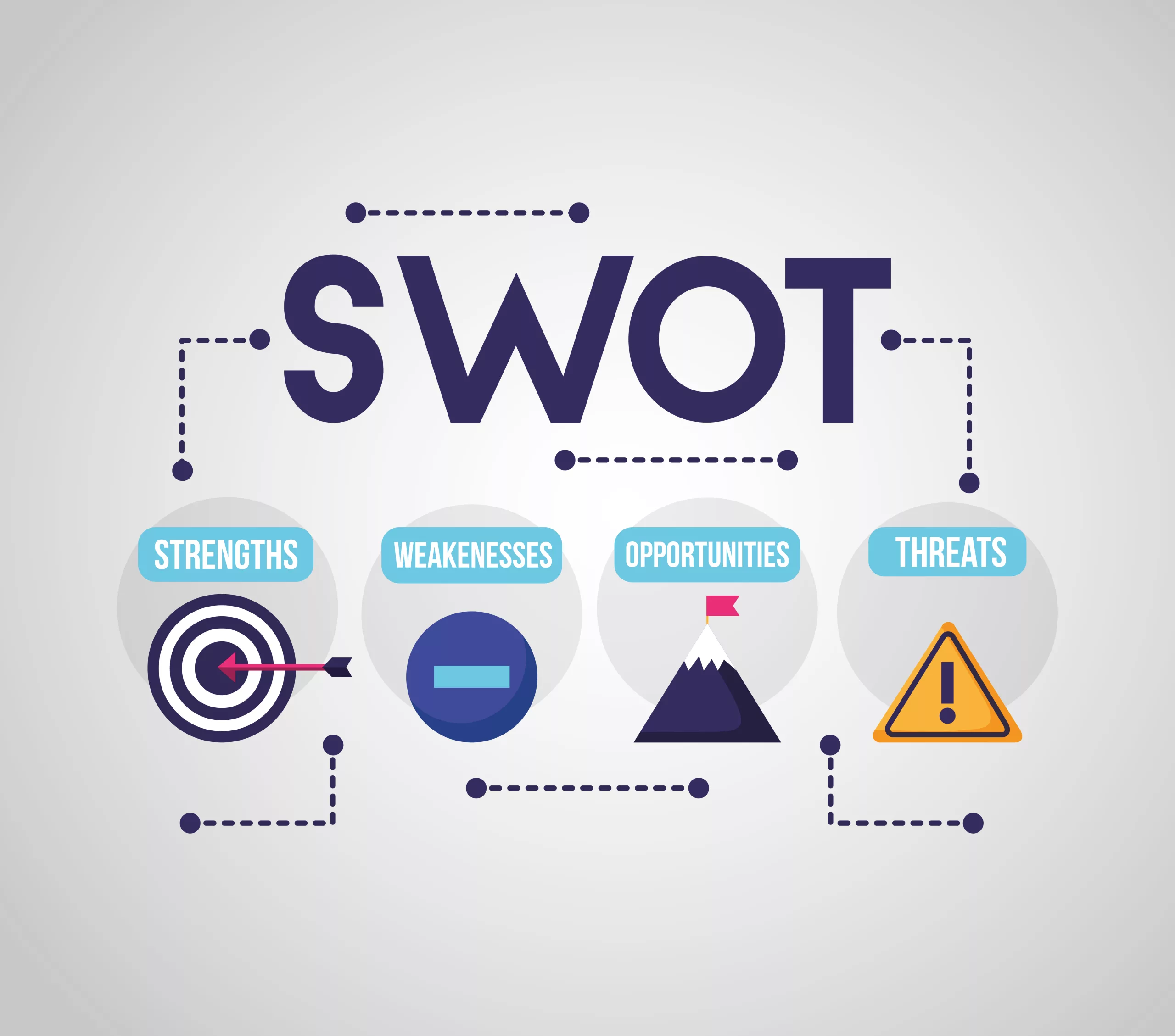In the dynamic world of nonprofit organizations, understanding your organization’s strategic position is crucial for success. SWOT Analysis for Nonprofits is a powerful tool designed to help you evaluate your Strengths, Weaknesses, Opportunities, and Threats.
This methodology enables you to gain deep insights into your current operations and future potential, thereby empowering you to navigate challenges effectively and capitalize on opportunities. By transforming weaknesses into strengths and threats into opportunities, you set the foundation for sustainable growth and impactful outcomes.
Importance of SWOT Analysis for Nonprofits
Understand the Internal and External Environment: A SWOT analysis helps nonprofits assess their internal capabilities (strengths and weaknesses) and external environment (opportunities and threats). This knowledge can be used to leverage strengths and opportunities and mitigate weaknesses and threats.
Strategic Planning: It’s an essential part of strategic planning. By understanding their SWOT, nonprofits can create strategies that capitalize on their strengths and opportunities and address their weaknesses and threats, ultimately helping them achieve their mission.
Optimize Resource Allocation: Nonprofits often operate with limited resources. A SWOT analysis can help identify areas where resources can be best utilized for maximum impact.
Fundraising: Knowledge of strengths can help nonprofits in their fundraising efforts by highlighting what they do well. Understanding weaknesses can help them address the potential concerns of donors and improve their operations.
Risk Management: By identifying threats, nonprofits can develop strategies to manage potential risks before they become serious issues.
Competitive Advantage: IT helps understand what sets them apart from similar organizations, which can be used to promote their unique strengths to potential donors, volunteers, and the communities they serve.
Decision Making: A well-made SWOT matrix helps in improving decision-making processes needed to evaluate the pros and cons of different paths of action.

Performing SWOT Analysis for Nonprofits
Performing a SWOT analysis for a nonprofit organization can be extremely beneficial. Here’s how you can perform a nonprofit SWOT analysis:
Gather Your Team
The first step in performing a SWOT analysis is to gather team members from different levels and departments of your organization. This could include the business owner, skilled staff, volunteers, board members, and even beneficiaries. Including different perspectives will make the analysis more thorough and accurate. It could be a good idea to bring in a neutral facilitator to guide the discussion and keep it on track.
Define the Objective
Before starting the SWOT matrix, it is important to have a clear understanding of why you are conducting it. Is it for the overall strategic planning of the organization? Or is it for a specific project or program? Having a clearly defined objective will guide the conversation and help keep it focused.
Strengths
Start the analysis by identifying the organization’s internal strengths. Think about what your non-profit organization does well, what resources you have at your disposal, and how you stand out from similar organizations. These could include a highly motivated and skilled workforce, a unique or innovative service or program, a robust volunteer base, or a strong brand and reputation. It’s crucial to understand these strengths as they are the building blocks for your strategies and are the resources you can leverage to capitalize on opportunities and minimize threats.
Weaknesses
This part of the analysis involves identifying areas where your organization can improve. It’s important to be honest and realistic here. This is not an exercise in fault-finding, but a chance to uncover key issues. Weaknesses might include a lack of funding, high staff turnover, a limited online presence, outdated technology or infrastructure, or a lack of clear strategic directions.
Opportunities
Next, you’ll want to identify any new opportunities that your organization could take advantage of. These will typically be coming from the external environment. External opportunities could include a growing need for your services, new technologies that could enhance your work, partnerships with other organizations in the nonprofit sector, new funding opportunities, or changes in government policy that could benefit your cause.
Threats
Lastly, identify any potential internal and external threats that could negatively affect your organization. Again, these will typically be external factors and could include things like changes in government policy, cuts to funding, increasing competition in your sector, or negative public perception or misinformation about your cause.
Analysis
Once you’ve completed all four sections of the SWOT analysis, take some time to thoroughly review and analyze the results. Look for ways to leverage your strengths and opportunities to overcome your weaknesses and threats. This might involve investing in staff training to overcome a skill gap, leveraging a strong brand to boost fundraising efforts, or capitalizing on a strong volunteer base to roll out new services or programs.

Develop a Strategy
Using the findings from your SWOT analyses, you can now develop a seamless action plan. This plan should aim to maximize your strengths and opportunities and minimize your weaknesses and threats. Make sure this plan is actionable and includes clear objectives, timelines, and responsibilities. Additionally, consider establishing performance metrics to track your progress and ensure you’re meeting your strategic goals.
Follow Up
The SWOT analysis is not a one-and-done activity. Make sure there are clear next steps in place, and schedule regular check-ins to review progress and make necessary adjustments. Keep in mind that circumstances can change, and the organization should be ready to adapt its strategy as needed. However, it is still a powerful tool to streamline your organization’s strategic planning process.
Non-profit SWOT Analysis Example
Let’s use an example of a hypothetical nonprofit organization that provides education support for underprivileged children.
Objective: To increase the reach of the organization’s services and secure more funding to support expansion plans.
Strengths:
- A strong network of dedicated volunteers.
- Established partnerships with local schools and community centers.
- High credibility and trust within the community.
- Successful past programs with measurable impact on children’s education.
Weaknesses:
- Dependence on a limited number of funding sources.
- Lack of a dedicated marketing team to increase visibility.
- Limited capacity for program expansion due to small staff size.
- Outdated technology infrastructure, making data management difficult.
Opportunities:
- Increased public interest and awareness about the education gap in underprivileged communities.
- Availability of government grants for education initiatives.
- Potential for partnership with corporate sponsors interested in corporate social responsibility.
- Advancements in online education technologies that could expand reach.
Threats:
- Increasing competition from similar nonprofits.
- Changes in government policy may affect grant availability.
- Economic downturn leading to decreased donations.
- Public perception shifts around privacy concerns in children’s online education.
From this SWOT analysis, the organization might decide to leverage its strong community credibility and the increased public interest in its cause (strength + opportunity) to secure more funding and improve the nonprofit. It might also decide to invest in upgrading its technology infrastructure to address its capacity issue and improve its nonprofit operations and even day-to-day business planning.
This organization could also consider developing a marketing strategy to increase its visibility and compete effectively with other nonprofits offering similar services (weakness + threat). Finally, it may need to think about diversifying its funding sources to reduce its dependence on a few donors and mitigate the impact of potential policy changes or economic downturns (weakness + threat).
Conclusion
Remember, the SWOT analysis is a great tool to help you understand your organization’s current position in relation to its environment. It’s a starting point for strategy development, not a solution in and of itself. The real value comes from the strategies and action plans that you develop from the analysis.



